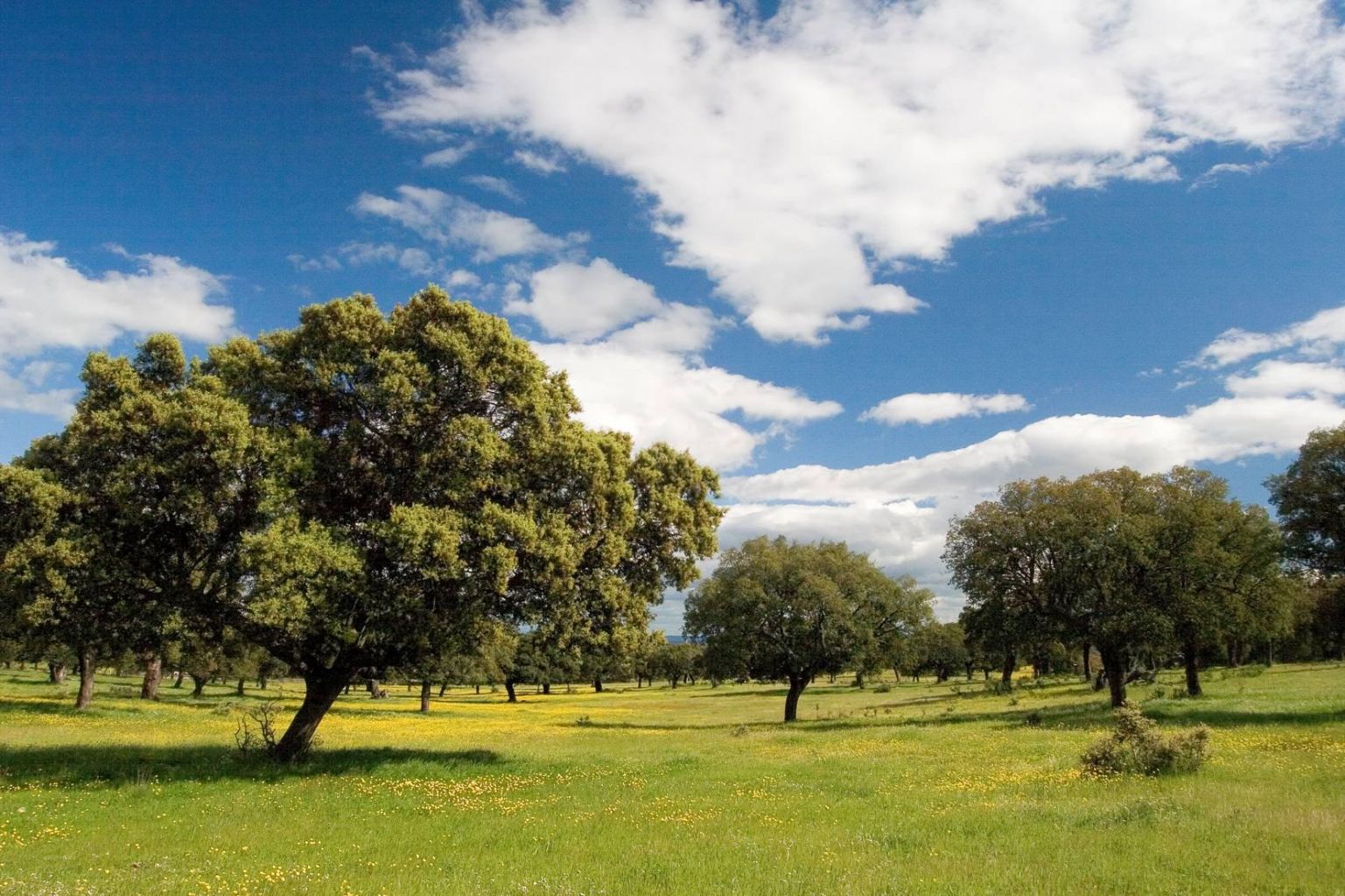
Σύστημα dehesa στηνΙσπανία
Περιγραφή του συστήματος
Dehesa είναι ένα αγροδασολιβαδικό σύστημα που προήλθε από την υπεραραίωση δασών αειθαλών πλατύφυλλων ειδών, όπου δέντρα, αυτοφυή αγρωστώδη, γεωργικά φυτά και αγροτικά ζώα αλληλεπιδρούν θετικά κάτω από ενιαία διαχείριση. Προς το παρόν, τα dehesas καταλαμβάνουν 2,3 εκατομμύρια εκτάρια στην Ισπανία και 0,7 εκατομμύρια εκτάρια στην Πορτογαλία, όπου ονομάζονται montados. Τα dehesas προέρχονται από την απλοποίηση της δομής και του πλούτου ειδών των μεσογειακών δασών και θαμνώνων και επιτυγχάνονται με τη μείωση της πυκνότητας των δέντρων, την εξάλειψη των θάμνων και την ευνόηση ποώδους υποβλάστησης δια μέσου της βόσκησης και γεωργικών καλλιεργειών. Τα dehesas χαρακτηρίζονται από την εκτροφή παραδοσιακών φυλών αγροτικών ζώων σε χαμηλές πυκνότητες βόσκησης και την συστηματική εκμετάλλευση των αείφυλλων δρυών. Τα dehesas συγκαταλέγονται μεταξύ των καλύτερα διατηρημένων χαμηλής έντασης αγροτικών συστημάτων στην Ευρώπη. Η ενσωμάτωση παραδοσιακής χρήσης γης και διατήρησης της βιοποικιλότητας σε αυτά θεωρείται υποδειγματική διαχείριση.
Αρχική συνάντηση των ενδιαφερόμενων φορέων
Η πρώτη συνάντηση των ενδιαφερόμενων φορέων πραγματοποιήθηκε στις 30 Μαΐου 2014 στη Σχολή Δασολογίας του Πανεπιστημίου της Extremadura, στην Plasencia. Η συνάντηση αυτή παρουσίασε μεγάλη συμμετοχή με την παρουσία περισσότερων από 90 ενδιαφερόμενων φορέων. Μεταξύ των συμμετεχόντων ήταν γεωργοί, κτηνοτρόφοι , δασολόγοι, γαιοκτήμονες, εκπρόσωποι περιφερειακών και εθνικών ενώσεων, εταιρείες αγροτικών υπηρεσιών, υπηρεσίες εφαρμογής , ΜΚΟ που σχετίζονται με τη φύση, τοπικές ομάδες δράσης και φορείς χάραξης πολιτικής. Έγινε μια εκτεταμένη ανάλυση των θετικών και αρνητικών απόψεων του συστήματος dehesa και των πιθανών καινοτομιών για έρευνα. Τα πιθανά θέματα που προσδιορίστηκαν για έρευνα ήταν: μέθοδοι αναγέννησης των δέντρων, εγκατάσταση λιβαδικών φυτών, βόσκηση και δυνατότητες εγκατάστασης ενός εμπορικού σήματος dehesa. Αν επιθυμείτε να μάθετε για τη δραστηριότητα αυτής της ομάδας, παρακαλούμε να επικοινωνήσετε με τον DrGerardoMoreno στο Πανεπιστήμιο της Extremadura.
Κατεβάστε την αρχική έκθεση ενδιαφερόμενων φορέων
Κατεβάστε το αρχικό πρωτόκολλο έρευνας και ανάπτυξης
Κατεβάστε την περιγραφή του συστήματος
A research update on dehesas in Spain was produced in December 2015.
Lessons learnt
Gerardo Moreno and colleagues at the University of Extremadura have written a comprehensive and informative report on the various innovations tested within the Dehesa stakeholder group in Spain.
The first part of the report focus on the search of alternative low cost shelters and practices for the regeneration of the trees of the dehesa. Some of the main lessons learnt are:
- Tree regeneration in the dehesa needs to be an integrated part of regular management practice; a rotational stage of grazing exclusion could be included in long-term farm management plans.
- Assisted regeneration can be based either on seeding acorns or on planting nursery-grown seedlings. Both approaches require seed and/or seedling protection.
- Application of cat/dog excrement around sown acorns can be recommended for small scale reforestation. CHANGE around young plants BY acorns sown
- Thorny wire-mesh tree guards proved to be an efficient, long-lasting solution and cheaper form of tree protection than classic wire mesh tree guards.
The second part of the report focuses on the option to improve fodder self-sufficiency by using protein-rich fodder crops and self-seeding pastures. Some of the main lessons learnt are:
- Three varieties of triticale are recommended; the trees can increase winter forage yields and the quality of the forage. The triticale can be grazed by livestock in the winter before the start of stem elongation.
- The sowing of legume-rich self-reseeding pasture can increase pasture productivity and quality for at least a decade. Grazing needs to be delayed in the initial years to ensure good establishment.
- The increase in the soil nitrogen, due to the legumes, also increases the protein content of other pasture species.
- The sowing of pasture increased the soil content of carbon accumulated. Although it reduced slightly the α diversity of plants, the total species richness (ϒ diversity) was unaltered.
- Farmers in the study reported that the improvement in the pasture quality and productivity offset the costs of the seed mixture and fertilizers.
The third part of the report focused on consumer acceptance for dehesa products and services. Some of the lessons learnt are:
- Consumers were more familiar with the term "dehesa" than "agroforestry"
- Consumers associated the dehesa with high-quality livestock products and a landscape of high cultural value.
- Possible dehesa products with development potential include asparagus, fungi and mushrooms, acorn-based foods, medicinal plants and cosmetics, herbs and herbal tea. CHANGE acorn beer BY acorn-based foods
Lastly the report highlights that more research is still needed on the use of new technologies (such as GPS collars) to improve dehesa management and the use of fast-intensive rotational management. Preliminary results also indicate that (ignoring the methane produced by livestock), a positive annual carbon balance of the dehesa of Majadas of about 0.5 t C/ha.